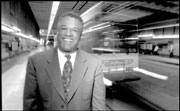THE DOWNTOWN bus tunnel is a flexible little hole. After a decade and a half as either the cause or the prospective cure for the city’s traffic jams, the 1.3 mile tunnel running under the heart of downtown once again finds itself at the center of our region’s transportation debate. This time, King County Executive Ron Sims is using the tunnel in order to try to save Sound Transit’s troubled light rail.
Originally, Sound Transit’s light rail was supposed to start running from the U District to Sea-Tac by 2006, at a cost of $1.8 billion. This year, however, several complications arose: First Sound Transit ran into funding problems with the federal government; next it was revealed that the cost of the project had ballooned to $4.1 billion; then the completion date was extended by three years; and, finally, the staff admitted that the project, as originally conceived, could not be built at all with the money available. Now the majority of Sound Transit’s board has expressed some support for Sims’ proposal to rejigger the light-rail plan and only build the southern leg of the line, from downtown to Sea-Tac airport or, perhaps, Southcenter. Buried somewhere among all the bulleted action items in Sims’ plan is a reiteration of the county exec’s suggestion that the downtown tunnel might accommodate both buses and trains.
It’s not the first time such a notion has surfaced. In fact, two-mode traffic was a key selling point when the tunnel was built in the 1980s (train tracks were laid during construction, even though there was no rail proposal on the horizon) and again when voters were asked to approve the massive Sound Transit ballot measure in 1996.
But two years ago, Sound Transit’s board concluded that joint operation of the tunnel wouldn’t work after all. With trains projected to come through the tunnel every four minutes, traffic engineers determined, it just didn’t make much sense to try to squeeze buses in, too. Delays were inevitable—not to mention additional costs and safety concerns—and, since it would be impossible to keep all the buses currently using the tunnel in the tunnel, the smartest option was to move them all upstairs to Third Avenue and give the tunnel over to the rail line.
Now Sims wants to revisit the idea of joint operation, and although some of the old complications remain, some important ones don’t. (More on that in a minute.) The larger point is that, with Sound Transit drowning in bad press and red ink, the politics of the issue have changed immensely.
At this point, not only is Sims likely to win support for joint operation from the same board that rejected it two years ago, but the future of the entire light-rail system likely depends on it.
SUPPORT FOR LIGHT RAIL is weakening, both among the public and in the federal government, whose $500 million first-phase grant is an important part of rail’s funding package. If someone doesn’t sound “all-aboard” pretty soon, in other words, the grant is likely to disappear and the death spiral quicken.
But there’s not enough time or money to deal with the problems facing the northern leg of the route, from downtown to the University District, mostly because of the problems associated with tunneling under Capitol Hill and the Ship Canal. That’s why Sims wants to go south. But what Sims argues—and Sound Transit’s projections back up—is that without going all the way to the northern end of downtown, the rail line won’t attract enough passengers to justify the project, explains the county exec’s transportation adviser David Hopkins, at least not in the eyes of the federal government. To have the best chance of getting the feds to hand over the dough for this new shortened rail line—and a formal petition is required, this summer—you need the tunnel.
But Sims is also trying to mollify the Downtown Seattle Association, a powerful business group that doesn’t want rail to force all those buses out of the tunnel and onto the streets, where traffic’s clogged enough as it is.
Thus the return of the idea that buses and trains should share the tunnel.
The irony, says King County Council member Rob McKenna, an opponent of light rail, is that Sound Transit’s failures might make the joint-operation plan feasible. Since the trains would stop at the northern end of downtown and not continue to Capitol Hill or the U District—where most of the passengers are—ridership may be low enough to allow both buses and trains in the tunnel.
Engineers are studying that possibility now, using computer modeling, and expect to have some answers by the end of the month. But the preliminary indication, says Sound Transit project manager Mike Williams, is that the once inadvisable is again possible. Coming from the south only, trains could enter the station only every five minutes, rather every four; more buses could then squeeze between them, and the risk of delays and accidents could be minimized. There are other technical concerns and costs still to be projected.
Overlaying it all is the reality that even if joint operations are now possible, everyone acknowledges it’s a temporary solution. Eventually, if light rail is extended to the U District, or as bus and southern rail’s ridership increases, the tunnel won’t be able to handle all the traffic—and the buses will get the boot.
Opponents of light rail, who argue that buses can move more people at a lower cost, may feel some of that intuitively, says McKenna, but haven’t immediately grasped that Sims’ joint-operation trial balloon is the nose-under-the-tent linchpin for the entire project.
“Most people don’t understand it well enough to oppose it,” he says regretfully.




